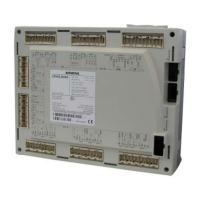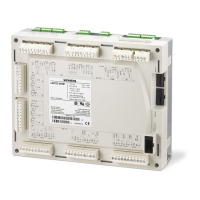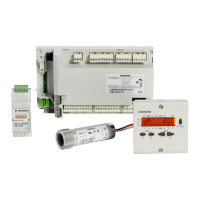
Do you have a question about the Siemens LMV52 series and is the answer not in the manual?
| Flame safeguard control | Yes |
|---|---|
| Air damper control | Yes |
| Fuel control | Yes |
| Ignition control | Yes |
| Approvals | CE, UL, CSA |
| Operating Temperature | -20...+60 °C |
| Certification | EN 298, EN 230 |
General safety instructions and warnings for operation to avoid injury, damage, or environmental harm.
Guidelines for proper physical installation, including compliance with national safety regulations and torque.
Crucial information on electrical wiring, compliance with standards, and EMC emission requirements.
Details on achieving disturbance-free signal transmission for flame detection components.
Essential safety checks to be performed when commissioning or maintaining the plant.
Important considerations for adjusting electronic fuel-air ratio control and burner identification.
Guidance for servicing the unit, including fuse replacement procedures.
Instructions for the proper disposal of electronic components according to legislation.
Details on the burner control's inputs, outputs, and their characteristics.
Describes flame detection methods and connections for QRI, ionization, QRB, QRA detectors.
Method to assign a 100% display value to any flame signal for better visualization.
Using an external approved flame safeguard for supervision.
Supervision of combustion chamber wall temperature in high-temperature plants.
Comprehensive list of digital inputs, their functions, and safety-related aspects.
Configuration of the critical safety loop input for direct shutdown.
Procedures for locking the system manually and performing resets.
Input for gas safety checks, valve proving, or valve closure contacts.
Details on all digital outputs, including safety-related (SI) and non-safety-related (No-SI).
Output for connecting ignition transformers or electronic igniters.
Outputs for controlling oil valves based on fuel train selection.
Outputs for controlling gas valves based on fuel train selection.
Detailed description of the burner control sequence and operational flow.
Critical safety parameters defining response times for flame loss and operation.
Safety function that ensures gas valves are not opened if a leak is detected.
Describes critical safety states, including lockout and initial safety phases.
Mapping of actuators to specific addresses for FARC system configuration.
Procedure for enabling or disabling actuators based on application and fuel type.
Operational sequence of the fuel-air ratio control system.
Safety checks for actuator positions and dynamic safety time.
Additional features for FARC, including program stop and load range settings.
Restricting the burner's working range by setting minimum and maximum load limits.
Defines how actuators behave in the event of a lockout.
Measures to prevent actuator damage due to overloads.
Details on different configurations for connecting load controllers.
Describes the controller's behavior in modulating and multistage modes.
Configuration and function diagrams for modulating operation.
Procedure for manually setting PID parameters for optimal control.
Automatic tuning process for PID controller parameters.
Control logic for multistage operation, including reaction thresholds.
Safety function to limit temperature and prevent overheating.
Protection mechanism to prevent thermal shock during cold starts.
Details on the pin assignments for AZL5 connections.
Information on the available communication ports (CAN, RS-232, BACS).
Procedure for connecting to a PC for parameterization and visualization.
Connecting to Building Automation and Control Systems (BACS) via Modbus.
Guide to navigating the AZL5 menu for displays and parameter settings.
Overview of the AZL5 menu hierarchy for accessing functions and settings.
Description of what is displayed during normal, undisturbed operation.
Understanding and interpreting lockout and error messages displayed by the AZL5.
How to access parameter settings, including password entry.
Procedure for addressing actuators and assigning their functions.
Detailed guide to parameterizing fuel-air ratio control curves for optimal burner performance.
Step-by-step instructions for editing individual points in the control curves.
Process for tuning the load controller's PID parameters automatically.
Procedures for performing TÜV safety and regulatory tests.
Initial system setup and configuration steps for the LMV5.
Specific parameter settings required for gas-fired burner operation.
Configuration steps for multistage oil-fired burner operation.
Procedure for performing the critical safety test for gas valves.
Steps to configure the load controller, including operating modes and sensors.
Methods for defining load controller parameters, including PID tuning.
Process for automatically tuning PID control parameters.
Detailed diagram of connection terminals for the LMV51.040x1 model.
Detailed diagram of connection terminals for LMV51.100x1, x2 and LMV51.140x2.
Terminal connections for various LMV51.3xx and LMV52.2xx/4xx models.
Terminal connections for specific LMV51.340x1 and LMV52.x40x1/x2 models.
Information on how to code the connectors for proper system function.
Details on powering the LMV5 unit using the AGG5.2 transformer.
Illustrative diagrams showing component installation and CAN bus connections.
Guidelines for determining maximum CAN bus cable lengths based on components.
Conditions and examples for when a second power transformer is necessary.
Responsibilities and checks required for authorized inspectors.
General technical specifications for the LMV5 and AZL5 units.
Electrical load ratings and cable specifications for terminals.
Requirements for operating environment, including climatic and mechanical conditions.
Core information about the Variable Speed Drive module and its connection.
Detailed description of the VSD module's inputs and outputs.
Procedure for configuring the VSD based on motor type and performance.
Automatic measurement function for standardizing VSD speeds.
Monitoring operational data such as static and dynamic speed deviations.
Diagrams illustrating VSD module terminal connections.
Detailed description of each terminal for the VSD module.
Explanation of how the O2 trim control system operates and reduces air.
Method for adjusting the O2 setpoint by manually lowering air rate.
How the system learns burner behavior and calculates air rate reduction.
Details on O2 trim control operation, including operating modes and alarms.
Description of various modes for O2 trim control and alarm activation.
Conditions under which the O2 minimum and maximum value alarms are deactivated.
Procedures for system self-testing to ensure QGO20 sensor functionality.
Method for detecting aging of the QGO20 O2 sensor.
Additional functions related to O2 trim control, like warnings and efficiency.
Information on the PLL52 module used for residual oxygen control.
Steps for configuring the PLL52 O2 module via the AZL5.
General system configuration, including actuators, VSDs, and fuel types.
Parameterization of actuators and VSDs for O2 trim control.
Selecting and setting fuel parameters for precontrol and efficiency calculations.
Step-by-step guide for setting up the O2 trim control system.
Crucial steps for setting fuel-air ratio control for optimal O2 trim performance.
Configuration of O2 alarms to ensure safe operation.
Setting safety limits for the O2 trim controller's manipulated variable.
Explanation of how the flue gas recirculation function reduces NOx content.
Details on the parameters that control FGR operation modes.
Instructions for integrating FGR with fuel-air ratio control for optimal performance.
FGR settings when temperature compensation is not used.
Specific FGR modes for LMV52.4, influencing temperature sensor evaluation.
How to read the operating temperature for FGR in LMV52.4.
Details on changes made to LMV51 units from series A to series B.
Overview of modifications introduced in various LMV5 software releases.
Summary of changes applied to the basic LMV5 unit across different software versions.
Specific software changes for the LMV51 basic unit from V02.10 to V02.20.
Information regarding the introduction of the V01.10 software version for LMV52.
Specific software changes for the LMV51 basic unit from V02.30 to V02.50.
Specific software changes for the LMV52 basic unit from V01.30 to V04.10.
Specific software changes for the LMV52 basic unit from V04.10 to V04.20.
Specific software changes for the LMV52 basic unit from V04.20 to V04.50.
Specific software changes for the LMV52 basic unit from V04.50 to V04.80.
Specific software changes for the LMV52.4 basic unit from V04.80 to V10.00.
Version information for the 2012/2013 software release upgrade.
Specific software changes for LMV51.0 and LMV51.1 from V02.50 to V05.10.
Specific software changes for the LMV51.3 basic unit from V04.80 to V05.10.
Information on the relaunch of the LMV50 variant with V10.20 software.
Specific software changes for the LMV52.2 basic unit from V04.80 to V05.10.
Specific software changes for the LMV52.4 basic unit from V10.00 to V10.20.
Software updates for LMV5 covering versions V05.10, V05.20, 10.20, V10.30.
Software modifications made to the load controller across different versions.
Specific software changes for the load controller from V01.40 to V01.50.
Specific software changes for the load controller from V01.50 to V01.60.
Specific software changes for the load controller from V01.60 to V01.80.
Specific software changes for the load controller from V01.80 to V02.10.
Information on software upgrades for the load controller from 2012/2013.
Software modifications for the Variable Speed Drive module.
Specific software changes for the VSD module from V01.30 to V01.40.
Specific software changes for the VSD module from V01.40 to V01.50.
Information on software upgrades for the VSD module from 2012/2013.
Modifications made to the AZL52 display and operating unit software.
Specific software changes for the AZL5 display and operating unit.
Specific software changes for the AZL52 display and operating unit.
Specific software changes for the AZL52 display and operating unit.
Specific software changes for the AZL52 display and operating unit.
Specific software changes for the AZL52 display and operating unit.
Specific software changes for the AZL52 display and operating unit.
Specific software changes for the AZL52 display and operating unit.
Specific software changes for the AZL52 display and operating unit.
Specific software changes for the AZL52 display unit from V05.00 to V05.10.












